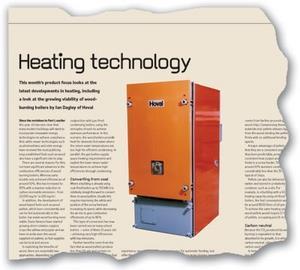So Bruce Boucher was confused by the example put forward in Ian Dagley’s article on biomass boilers (BSJ 08/06); I will try to elaborate.
Yes, generally the space heating requirements of a building will be greater than the DHW needs; until perhaps we start building ‘properly’ and drive down space heating requirements to zero!
Yes, if the aim is to maximise renewable heat supply then one would size the biomass boiler to take at least base load and possibly use a gas and/or oil boiler for peaking/back-up/summer load. The design can be very specific to the type of building and its use. Perhaps unfortunately, the ‘Merton Rule’ and Part L demand a percentage cut in carbon emissions. Developers quite naturally aim to minimise costs by just hitting the required target. This is perhaps the paradox policy makers find themselves in – we want x% renewable heat across all buildings, but is it perhaps illogical to require every building to split its consumption according to national or international targets?
There is a risk of the discussion becoming pro-pellet or pro-chip, which I do not think is useful as both fuels have significant roles – the important issue is that the use of biomass for heat increases in the UK. It can be very misleading to quote prices for either option – our advice to clients is to get as close to a pellet manufacturer as possible and negotiate a long-term contract, possibly pegged to fossil prices. Without forced drying or blending with recycled material, I understand it is extremely difficult to get chip consistently as low as 25% m.c. in our temperate climate. The lower end of Bruce Boucher’s pricing for chip is around that paid by the panel board/pulp industry simply because ‘they can’ – the alternative heat market is only just getting going and ultimately it is the p/kWh of useful heat that needs to be compared. Most end-users in the small-scale heat market will ultimately require a more, dare I say, ‘refined’ fuel, whether chip or pellet.
I agree with his point that ideally local biomass is best, however the energy density of pellets, their low moisture content and the fact that they are already an internationally traded commodity is of interest. Academic studies have shown that the ‘carbon cost’ of producing pellets using oil for conditioning, ‘brown’ electricity for processing, shipping from Canada and by road to a UK site is still massively favourable in comparison with natural gas. UK pellet sources are increasing all the time and market economics will drive further development and price normalisation.
These are interesting times for all involved in the industry; it seems at last policy is beginning to work with us. If our aspirations for biomass heat come to fruition over the next 10-15 years, then surely wood fuels will ultimately come under the same market pressures as the fossil ‘alternatives’. 7% of the heat market is a challenging target for all of us!
Nick Monether, product manager - Biomass and Renewable Energy, Hoval
Source
Building Sustainable Design























No comments yet